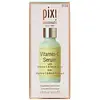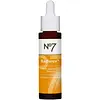What's inside
What's inside
 Key Ingredients
Key Ingredients

 Benefits
Benefits

 Concerns
Concerns

 Ingredients Side-by-side
Ingredients Side-by-side

Water
Skin ConditioningAscorbic Acid
AntioxidantEthoxydiglycol
HumectantPropanediol
SolventGlycerin
HumectantCitrus Grandis
Sodium Hydroxide
BufferingAloe Barbadensis Leaf Juice
Skin ConditioningSodium Hyaluronate
HumectantCitrus Limon Peel Extract
EmollientCitrus Nobilis
Citrus Aurantium Dulcis Fruit Extract
MaskingFerulic Acid
AntimicrobialTocopherol
AntioxidantCaffeine
Skin ConditioningMicrocitrus Australis Fruit Extract
Skin ConditioningMicrocitrus Australasica Fruit Extract
Beta-Carotene
Skin ConditioningLecithin
EmollientCitrus Glauca Fruit Extract
HumectantPanthenol
Skin ConditioningDaucus Carota Sativa Root Extract
Skin ConditioningCitrus Aurantium Dulcis Peel Extract
Emulsion StabilisingCitrus Grandis Fruit Extract
AstringentCitrus Junos Peel Extract
Skin ConditioningMentha Piperita Extract
CleansingMelaleuca Alternifolia Flower/Leaf/Stem Extract
Skin ConditioningRetinol
Skin ConditioningXanthan Gum
EmulsifyingLeuconostoc/Radish Root Ferment Filtrate
AntimicrobialPunica Granatum Extract
AstringentPhenoxyethanol
PreservativeHydroxypropyl Cyclodextrin
MaskingPolysorbate 20
EmulsifyingPhospholipids
Skin ConditioningGlycine Soja Oil
EmollientCaprylic/Capric Triglyceride
MaskingSodium Acrylates Copolymer
Sodium Benzoate
MaskingPotassium Sorbate
PreservativeSodium Sorbate
PreservativeCitric Acid
BufferingEthylhexylglycerin
Skin ConditioningWater, Ascorbic Acid, Ethoxydiglycol, Propanediol, Glycerin, Citrus Grandis, Sodium Hydroxide, Aloe Barbadensis Leaf Juice, Sodium Hyaluronate, Citrus Limon Peel Extract, Citrus Nobilis, Citrus Aurantium Dulcis Fruit Extract, Ferulic Acid, Tocopherol, Caffeine, Microcitrus Australis Fruit Extract, Microcitrus Australasica Fruit Extract, Beta-Carotene, Lecithin, Citrus Glauca Fruit Extract, Panthenol, Daucus Carota Sativa Root Extract, Citrus Aurantium Dulcis Peel Extract, Citrus Grandis Fruit Extract, Citrus Junos Peel Extract, Mentha Piperita Extract, Melaleuca Alternifolia Flower/Leaf/Stem Extract, Retinol, Xanthan Gum, Leuconostoc/Radish Root Ferment Filtrate, Punica Granatum Extract, Phenoxyethanol, Hydroxypropyl Cyclodextrin, Polysorbate 20, Phospholipids, Glycine Soja Oil, Caprylic/Capric Triglyceride, Sodium Acrylates Copolymer, Sodium Benzoate, Potassium Sorbate, Sodium Sorbate, Citric Acid, Ethylhexylglycerin
Water
Skin Conditioning3-O-Ethyl Ascorbic Acid
Skin ConditioningPropylene Glycol
HumectantPolysorbate 20
EmulsifyingPolyacrylate Crosspolymer-6
Emulsion StabilisingEthylhexylglycerin
Skin ConditioningSodium Hyaluronate
HumectantBenzyl Alcohol
PerfumingAllantoin
Skin ConditioningXanthan Gum
EmulsifyingPEG-40 Hydrogenated Castor Oil
EmulsifyingSodium Citrate
BufferingLimonene
PerfumingDipropylene Glycol
HumectantLinalool
PerfumingT-Butyl Alcohol
PerfumingParfum
MaskingCitric Acid
BufferingDenatonium Benzoate
MaskingWater, 3-O-Ethyl Ascorbic Acid, Propylene Glycol, Polysorbate 20, Polyacrylate Crosspolymer-6, Ethylhexylglycerin, Sodium Hyaluronate, Benzyl Alcohol, Allantoin, Xanthan Gum, PEG-40 Hydrogenated Castor Oil, Sodium Citrate, Limonene, Dipropylene Glycol, Linalool, T-Butyl Alcohol, Parfum, Citric Acid, Denatonium Benzoate
 Reviews
Reviews

Ingredients Explained
These ingredients are found in both products.
Ingredients higher up in an ingredient list are typically present in a larger amount.
Citric Acid is an alpha hydroxy acid (AHA) naturally found in citrus fruits like oranges, lemons, and limes.
Like other AHAs, citric acid can exfoliate skin by breaking down the bonds that hold dead skin cells together. This helps reveal smoother and brighter skin underneath.
However, this exfoliating effect only happens at high concentrations (20%) which can be hard to find in cosmetic products.
Due to this, citric acid is usually included in small amounts as a pH adjuster. This helps keep products slightly more acidic and compatible with skin's natural pH.
In skincare formulas, citric acid can:
While it can provide some skin benefits, research shows lactic acid and glycolic acid are generally more effective and less irritating exfoliants.
Most citric acid used in skincare today is made by fermenting sugars (usually from molasses). This synthetic version is identical to the natural citrus form but easier to stabilize and use in formulations.
Read more about some other popular AHA's here:
Learn more about Citric AcidEthylhexylglycerin (we can't pronounce this either) is commonly used as a preservative and skin softener. It is derived from glyceryl.
You might see Ethylhexylglycerin often paired with other preservatives such as phenoxyethanol. Ethylhexylglycerin has been found to increase the effectiveness of these other preservatives.
Polysorbate 20 is made by combining ethoxylation of sorbitan, ethylene oxide, and lauric acid. It is a mild cleansing agent, surfactant, and emulsifier.
As a surfactant, it helps collect dirt and oils for washing. Emulsifiers prevent oils and water from separating.
Polysorbate 20 also adds scent to a product. Since it is made using sorbitol, it has a sweet scent. Sorbitol can also be found in fruits such as apples and peaches.
The lauric acid used to create Polysorbate 20 is often derived from coconuts.
Polysorbate 20 may not be fungal acne safe.
Learn more about Polysorbate 20Sodium Hyaluronate is hyaluronic acid's salt form. It is commonly derived from the sodium salt of hyaluronic acid.
Like hyaluronic acid, it is great at holding water and acts as a humectant. This makes it a great skin hydrating ingredient.
Sodium Hyaluronate is naturally occurring in our bodies and is mostly found in eye fluid and joints.
These are some other common types of Hyaluronic Acid:
Learn more about Sodium HyaluronateWater. It's the most common cosmetic ingredient of all. You'll usually see it at the top of ingredient lists, meaning that it makes up the largest part of the product.
So why is it so popular? Water most often acts as a solvent - this means that it helps dissolve other ingredients into the formulation.
You'll also recognize water as that liquid we all need to stay alive. If you see this, drink a glass of water. Stay hydrated!
Learn more about WaterXanthan gum is used as a stabilizer and thickener within cosmetic products. It helps give products a sticky, thick feeling - preventing them from being too runny.
On the technical side of things, xanthan gum is a polysaccharide - a combination consisting of multiple sugar molecules bonded together.
Xanthan gum is a pretty common and great ingredient. It is a natural, non-toxic, non-irritating ingredient that is also commonly used in food products.
Learn more about Xanthan Gum